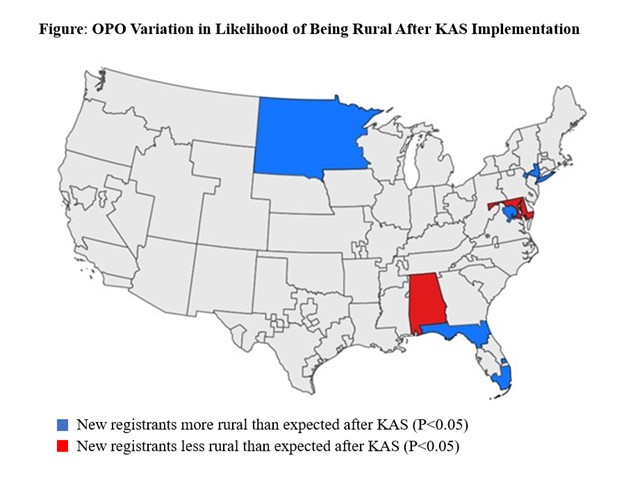Disparities in Access to Listing in Rural Populations Post-KAS Implementation
1Department of Surgery, University of Wisconsin School of Medicine and Public Health, Madison, WI, 2Department of Surgery, University of Pennsylvania, Philadelphia, PA, 3Department of Surgery, Brigham and Women’s Hospital, Boston, MA
Meeting: 2021 American Transplant Congress
Abstract number: 287
Keywords: Allocation, Kidney transplantation, Risk factors, Waiting lists
Topic: Clinical Science » Organ Inclusive » Non-Organ Specific: Disparities to Outcome and Access to Healthcare
Session Information
Session Name: Disparities in Access and Outcomes in Kidney Transplantation
Session Type: Rapid Fire Oral Abstract
Date: Monday, June 7, 2021
Session Time: 6:00pm-7:00pm
 Presentation Time: 6:30pm-6:35pm
Presentation Time: 6:30pm-6:35pm
Location: Virtual
*Purpose: One major goal of the Kidney Allocation System (KAS) was to improve access to transplantation. The impact of KAS on rural populations has been poorly studied; here we assess access to the waitlist for rural populations compared to their urban counterparts.
*Methods: Using the Scientific Registry of Transplant Recipients, we assessed changes in demographics of rural and urban patients listed pre-KAS (2010-2013) and post-KAS (2015-2018). Rurality was determined by candidate home address with Rural-Urban Commuting Area Codes. Access to transplant, measured via waitlist composition, being listed pre-dialysis, and dialysis time at registration, was analyzed using multiple regression.
*Results: Overall, listings increased by 5,966 patients under KAS. Although rural patients make up 24.3% of the total waitlist registrant cohort, only 12.5% (n=746) of increased listings post-KAS were rural, suggesting they had less benefit from KAS than urban patients (P<0.001, Table). Adjusting for patient demographics, comorbidities, and organ procurement organization (OPO), post-KAS new listings were less likely to be from rural areas than pre-KAS (OR 0.97 [0.94-0.98], P<0.001). 5 OPOs increased rural registrants while 2 decreased (P<0.05, Figure) after KAS. Post-KAS status was associated with a slight increase in days on dialysis (95.3±5.2 days, P<0.001) and being listed preemptively (OR 1.51 [1.47-1.54], P<0.001), but neither were related to rural status (P=0.95).
*Conclusions: Although KAS increased overall access to listing by increasing waitlist registration and preemptive listing, it generally disfavors rural versus urban populations. Further efforts are needed to evaluate causes of these disparities and the downstream effects on transplantation.
To cite this abstract in AMA style:
Nguyen SH, Redfield RR, Neidlinger N, Foley DP, Kaufman DB, Adler JT. Disparities in Access to Listing in Rural Populations Post-KAS Implementation [abstract]. Am J Transplant. 2021; 21 (suppl 3). https://atcmeetingabstracts.com/abstract/disparities-in-access-to-listing-in-rural-populations-post-kas-implementation/. Accessed December 27, 2025.« Back to 2021 American Transplant Congress


